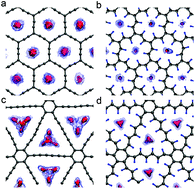Our official English website, www.x-mol.net, welcomes your
feedback! (Note: you will need to create a separate account there.)
Atomistic and continuum scale modeling of functionalized graphyne membranes for water desalination†
Nanoscale ( IF 5.8 ) Pub Date : 2018-02-01 00:00:00 , DOI: 10.1039/c7nr07963j Muralikrishna Raju 1, 2, 3, 4 , Pavan B. Govindaraju 1, 2, 3, 4 , Adri C. T. van Duin 4, 5, 6, 7 , Matthias Ihme 1, 2, 3, 4
Nanoscale ( IF 5.8 ) Pub Date : 2018-02-01 00:00:00 , DOI: 10.1039/c7nr07963j Muralikrishna Raju 1, 2, 3, 4 , Pavan B. Govindaraju 1, 2, 3, 4 , Adri C. T. van Duin 4, 5, 6, 7 , Matthias Ihme 1, 2, 3, 4
Affiliation

|
Recent theoretical and experimental studies reported ultra-high water permeability and salt rejection in nanoporous single-layer graphene. However, creating and controlling the size and distribution of nanometer-scale pores pose significant challenges to application of these membranes for water desalination. Graphyne and hydrogenated graphyne have tremendous potential as ultra-permeable membranes for desalination and wastewater reclamation due to their uniform pore-distribution, atomic thickness and mechano-chemical stability. Using molecular dynamics (MD) simulations and upscale continuum analysis, the desalination performance of bare and hydrogenated α-graphyne and γ-{2,3,4}-graphyne membranes is evaluated as a function of pore size, pore geometry, chemical functionalization and applied pressure. MD simulations show that pores ranging from 20 to 50 Å2 reject in excess of 90% of the ions for pressures up to 1 GPa. Water permeability is found to range up to 85 L cm−2 day−1 MPa−1, which is up to three orders of magnitude larger than commercial seawater reverse osmosis (RO) membranes and up to ten times that of nanoporous graphene. Pore chemistry, functionalization and geometry are shown to play a critical role in modulating the water flux, and these observations are explained by water velocity, density, and energy barriers in the pores. The atomistic scale investigations are complemented by upscale continuum analysis to examine the performance of these membranes in application to cross-flow RO systems. This upscale analysis, however, shows that the significant increase in permeability, observed from MD simulations, does not fully translate to current RO systems due to transport limitations. Nevertheless, upscale calculations predict that the higher permeability of graphyne membranes would allow up to six times higher permeate recovery or up to 6% less energy consumption as compared to thin-film composite membranes at currently accessible operating conditions. Significantly higher energy savings and permeate recovery can be achieved if higher feed-flow rates can be realized.
中文翻译:

用于水脱盐的功能化石墨炔膜的原子尺度和连续尺度建模†
最近的理论和实验研究报道了纳米多孔单层石墨烯的超高透水性和脱盐率。然而,创建和控制纳米级孔的尺寸和分布对这些膜用于水脱盐的应用提出了重大挑战。石墨烯和氢化石墨烯因其均匀的孔分布,原子厚度和机械化学稳定性而具有极高的潜力,可作为用于海水淡化和废水回收的超渗透膜。使用分子动力学(MD)模拟和高档连续分析,评估裸露的和氢化的α-石墨烯和γ-{2,3,4}-石墨烯膜的脱盐性能与孔径,孔几何形状,化学官能度和施加压力。2拒绝在过量的离子的90%压力达为1GPa。发现水渗透率的范围最高为85 L cm -2天-1 MPa -1比商用海水反渗透(RO)膜大3个数量级,是纳米多孔石墨烯的10倍。孔隙化学,功能化和几何形状在调节水通量中起着至关重要的作用,这些观察结果可以通过孔隙中的水流速,密度和能垒来解释。原子尺度研究辅以高档连续分析,以检查这些膜在错流反渗透系统中的性能。然而,这种高端分析表明,由于运输限制,从MD模拟中观察到的渗透率的显着提高并未完全转化为当前的RO系统。尽管如此,高端计算预测,与目前可操作的薄膜复合膜相比,石墨烯膜的较高渗透性将使渗透物回收率提高多达六倍,或能耗降低多达6%。如果可以实现更高的进料流速,则可以显着提高能耗和渗透物回收率。
更新日期:2018-02-01
中文翻译:

用于水脱盐的功能化石墨炔膜的原子尺度和连续尺度建模†
最近的理论和实验研究报道了纳米多孔单层石墨烯的超高透水性和脱盐率。然而,创建和控制纳米级孔的尺寸和分布对这些膜用于水脱盐的应用提出了重大挑战。石墨烯和氢化石墨烯因其均匀的孔分布,原子厚度和机械化学稳定性而具有极高的潜力,可作为用于海水淡化和废水回收的超渗透膜。使用分子动力学(MD)模拟和高档连续分析,评估裸露的和氢化的α-石墨烯和γ-{2,3,4}-石墨烯膜的脱盐性能与孔径,孔几何形状,化学官能度和施加压力。2拒绝在过量的离子的90%压力达为1GPa。发现水渗透率的范围最高为85 L cm -2天-1 MPa -1比商用海水反渗透(RO)膜大3个数量级,是纳米多孔石墨烯的10倍。孔隙化学,功能化和几何形状在调节水通量中起着至关重要的作用,这些观察结果可以通过孔隙中的水流速,密度和能垒来解释。原子尺度研究辅以高档连续分析,以检查这些膜在错流反渗透系统中的性能。然而,这种高端分析表明,由于运输限制,从MD模拟中观察到的渗透率的显着提高并未完全转化为当前的RO系统。尽管如此,高端计算预测,与目前可操作的薄膜复合膜相比,石墨烯膜的较高渗透性将使渗透物回收率提高多达六倍,或能耗降低多达6%。如果可以实现更高的进料流速,则可以显着提高能耗和渗透物回收率。











































 京公网安备 11010802027423号
京公网安备 11010802027423号